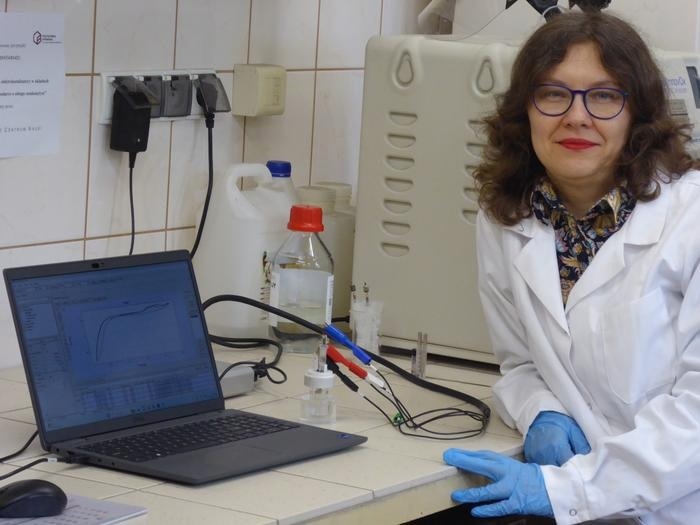Reviewed by Danielle Ellis, B.Sc.Sep 19 2024
A promising solution to recycling lithium-ion batteries was presented by scientists from several Polish research institutions, including the Institute of Fundamental Technological Research of the Polish Academy of Sciences, the Institute of Physical Chemistry of the PAS in Warsaw, the Bydgoszcz University of Science and Technology (PBS), and the Wroclaw University of Science and Technology, in the journal ChemElectroChem.
 Dr. Eng. Magdalena Warczak at the measuring system with a glassy carbon electrode covered with powder obtained from spent lithium-ion batteries. Image Credit: PBS / jch
Dr. Eng. Magdalena Warczak at the measuring system with a glassy carbon electrode covered with powder obtained from spent lithium-ion batteries. Image Credit: PBS / jch
In just the last four years, the use of lithium-ion batteries has doubled worldwide, producing a frightening amount of battery waste that contains numerous hazardous materials. Effective techniques for recycling spent lithium-ion batteries are becoming increasingly important.
Carbon material taken from the electrodes of spent lithium-ion batteries (LIBs) served as the study's foundation. To recover valuable metals, these electrodes were subjected to an acidic leaching procedure.
The resulting carbon material was somewhat etched depending on the experimental setup, and even after it was powdered, it contained traces of metals, including cobalt, a metal that is frequently used in catalysis. With an emphasis on those that aid in the synthesis of hydrogen peroxide, the research sought to repurpose these battery materials for use in catalytic processes.
Hydrogen peroxide is one of the fundamental chemical molecules, essential to numerous industries. Large-scale production of this substance typically demands high pressures and temperatures, costly catalysts, and various toxic electrolytes. Our focus was on developing a more environmentally friendly method for producing hydrogen peroxide: specifically, an electrochemical approach using catalysts derived from used lithium-ion batteries.
Dr. Eng. Magdalena Warczak, Project Leader and Study Lead Author, Bydgoszcz University of Science and Technology (PBS)
Materials recovered from spent LIB batteries that contain cobalt and carbon nanostructures exhibit catalytic properties in the oxygen reduction reaction, according to electrochemical tests. Nevertheless, it was also discovered that these characteristics are strongly reliant on the kind of sample, more specifically on its structure and composition, which are greatly impacted by the makeup of the etching baths used to clean the electrodes that were removed from lithium-ion batteries.
For potential future applications, the crucial finding is that, based on data gathered from experiments using a rotating electrode, we were able to determine the number of electrons involved in the reduction of a single oxygen molecule. The electrochemical reduction of oxygen can occur with either four or two electrons. In the case of four electrons, water is produced, but with two electrons, we obtain the desired hydrogen peroxide. In all the samples we tested, we observed the two-electron reduction.
Dr. Eng. Magdalena Warczak, Project Leader and Study Lead Author, Bydgoszcz University of Science and Technology (PBS)
The measurements were repeated in systems where individual battery powders were suspended between two immiscible liquids to rule out any potential effects of the glassy carbon electrode used as a substrate on the outcomes. Decamethylferrocene, a substance that contributes electrons to the oxygen reduction reaction under investigation, was present in the organic liquid. At the liquid-liquid interface, spontaneous oxygen reduction took place.
These investigations verified that all samples catalyzed the oxygen reduction reaction to produce hydrogen peroxide, which is in line with the experiments conducted with the glassy carbon electrode. Using a scanning electrochemical microscope, the hydrogen peroxide concentrations at the interface were one to two orders of magnitude higher than in systems without battery waste.
“Lithium-ion batteries have generally been viewed as just a secondary source of carbon materials, mainly graphite, and metals like lithium, cobalt, or nickel. Meanwhile, our group's findings clearly demonstrate that battery waste can catalyze the reduction of oxygen to hydrogen peroxide, and in the future, this could lead to its use in producing this important chemical compound,” concluded Dr. Warczak.
Although its efficacy for wound care is questionable, pharmacies sell hydrogen peroxide at a 3% concentration as a disinfectant for wounds and inflammation. Bleaches are solutions with concentrations as high as 15% that are used in cosmetics like hair lighteners and household cleaning products. In many industries, such as chemical manufacturing (for peroxide synthesis and as an oxidant), pulp, paper, and textiles (as a bleach), rubber (as a raw material), electronics and metal (as an etching agent), and food processing (as a biocidal substance), a solution with about a 30% concentration is known as hydrogen peroxide.
It is interesting to note that hydrogen peroxide can oxidize fuels, including rocket fuel. It first served this role in the 1940s, when it was used in early rockets capable of crossing the conventional space boundary. But at that time, its concentrations did not go above 80%, and the long-term missions were hampered by technological constraints. In contrast, hydrogen peroxide is one of the most environmentally friendly propellants at high concentrations (98% or more). It was only a few weeks ago that it was put to use in space, powering a suborbital rocket constructed at the Lukasiewicz Institute of Aviation in Warsaw for the first time.
Previously supported by a SONATA grant from the Polish National Science Center, research on the synthesis of hydrogen peroxide from carbon materials recovered from spent lithium-ion batteries will continue. The main goal will be to raise electrochemical reaction efficiency to a level appropriate for use in industry later on. In the future, four-electron reduction will also be investigated for possible fuel cell uses.
Journal Reference:
Warczak, M., et al. (2024) Insights into the High Catalytic Activity of Li-Ion Battery Waste toward Oxygen Reduction to Hydrogen Peroxide. ChemElectroChem. doi.org/10.1002/celc.202400248